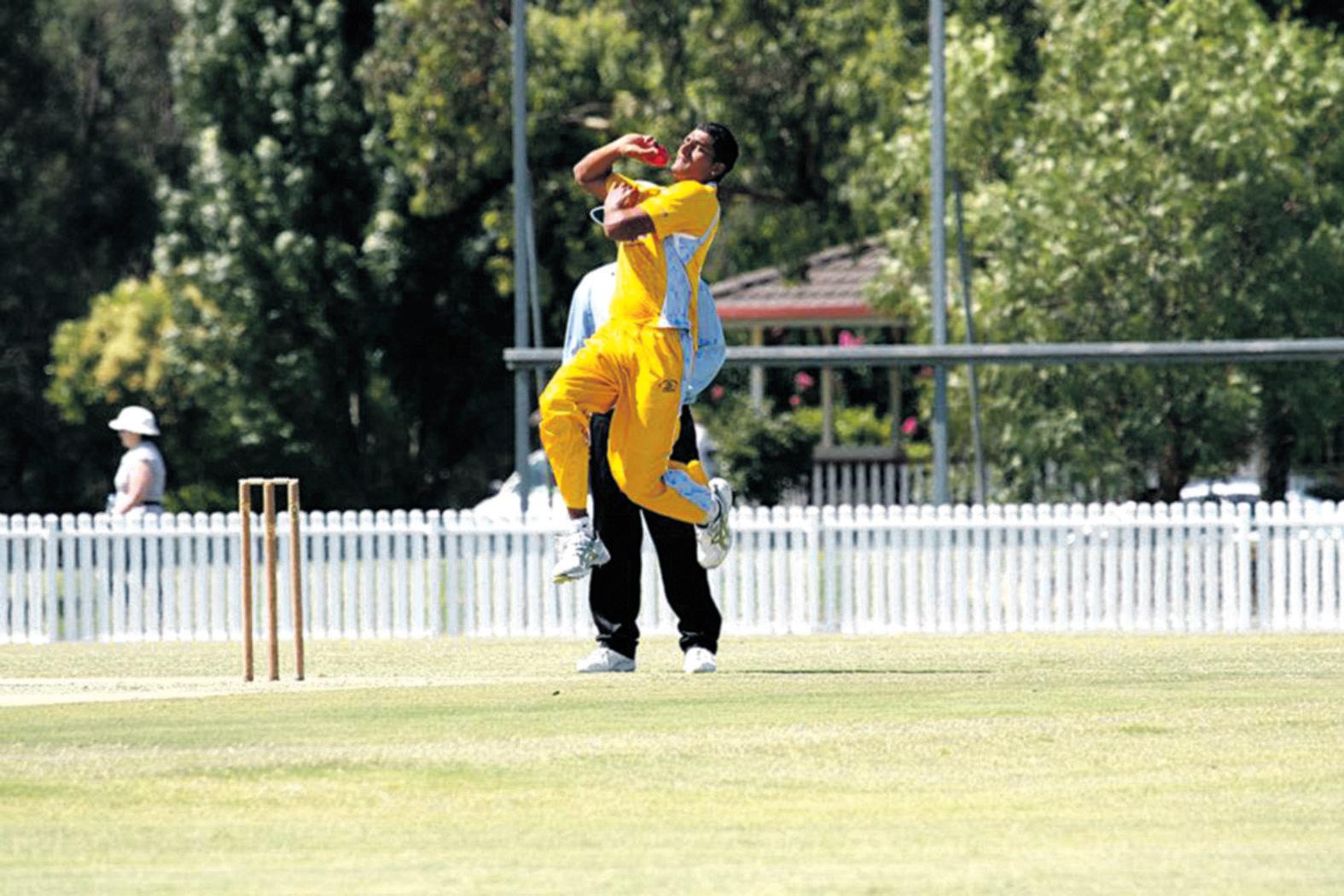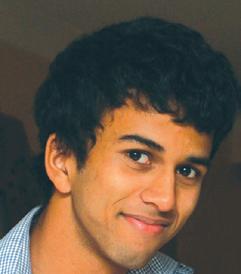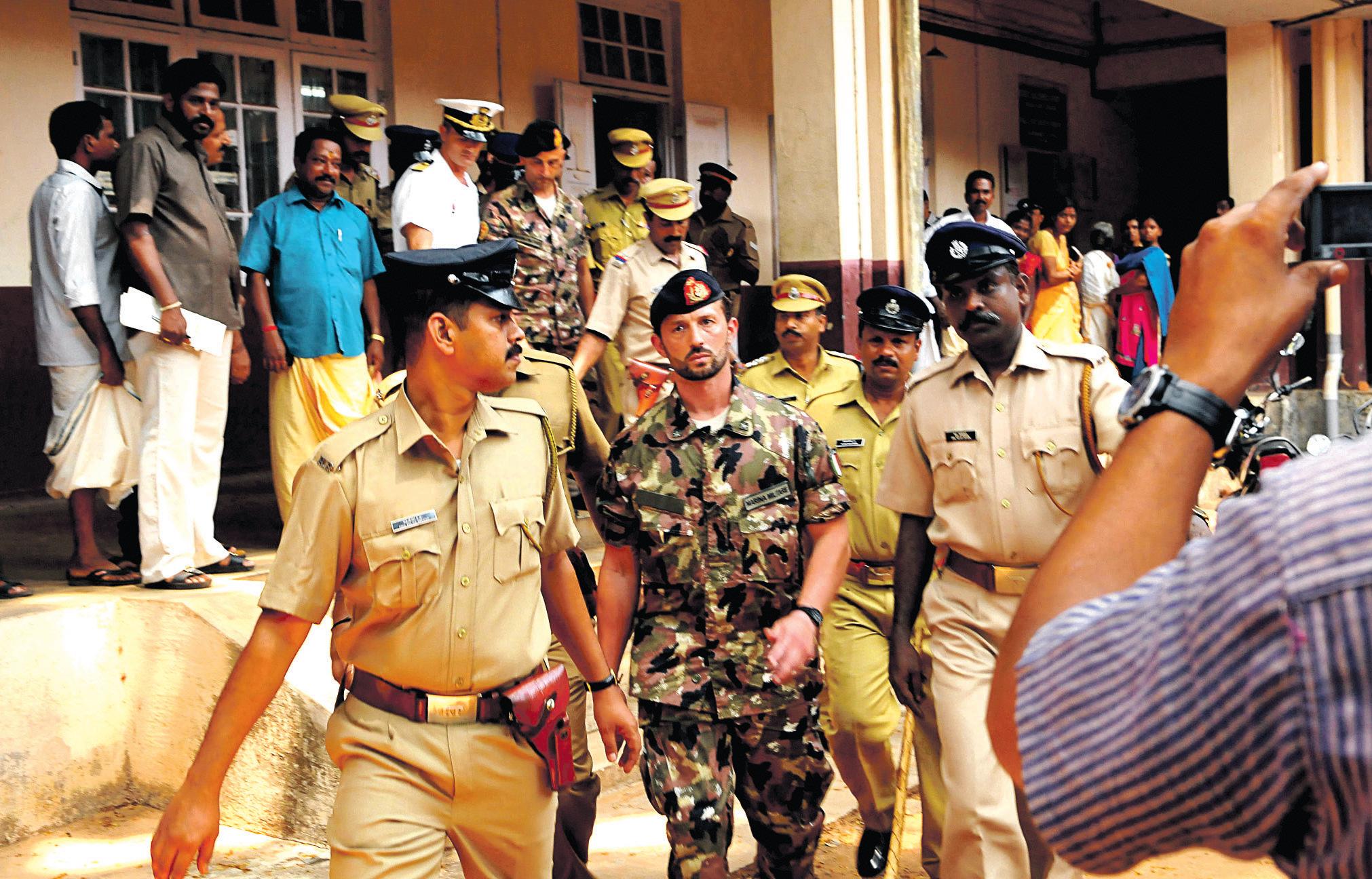
16 minute read
Game on for Gurinder!
from 2012-03 Sydney (2)
by Indian Link
A talented young cricketer makes it to the U19s international big league
By RITAM MITRA
Just four years ago, Virat Kohli successfully captained an Indian side to the 2008 U/19 World Cup title. He is now one of the pre-eminent batsmen of the modern game. The same edition of the tournament featured big names such as James Pattinson, Tim Southee, Wayne Parnell, Darren Bravo – the list is scattered with future international superstars. The importance of the tournament is underlined by these names as the stepping stones the competition provides - for instance Kohli is now India’s oneday international vice-captain, and is already being touted as the future captain.
How it must feel then, for Gurinder Sandhu, a young Australian fast bowler who was, earlier this month, selected in the 30-man squad for the U/19 World Cup taking place in August.
The tournament will be held in Townsville, Brisbane and the Sunshine Coast, with more than 400 cricketers from 14 nations making the trip to the sunshine state. Australia are the reigning champions, after the Mitchell Marsh-led side won the 2010 trophy in New Zealand. An international quadrangular series will also be held in April between Australia, India, New Zealand and England, giving the players another opportunity to gain exposure and experience playing on an international stage. Gurinder was also selected in the 15-man squad for this series.
Cricket Australia’s Talent Manager, Greg Chappell, is looking forward to watching the side in action. “I’m sure all the players are looking forward to continuing their development as part of this preliminary squad,” he said. “Quite a few players already have experience playing at the U19 international level, and more players will get that opportunity over the coming months”.
“Players such as Pat Cummins, Cameron Bancroft, Kurtis Patterson, Travis Head and Meyrick Buchanan have already had opportunities playing at the domestic level, while quite a few more have also played at Futures League level this season,” added Mr Chappell.
Currently a member of Fairfield-Liverpool’s first grade squad, Gurinder has already bowled to some big names: Simon Katich, Usman Khawaja, David Warner and Phil Hughes have all faced up to him, among a host of other names, including the touring 2009 Pakistan side. This is just one of the fruits of a tough training regime, which includes 2-4 days of training a week followed by matches on the weekends.
For Gurinder though, the journey began several years ago through his experiences in the junior representative teams.

“I first played in the 1999 cricket season in the local under10s side,” recalls Gurinder. “My favourite memory as a child would be when I played in under 11s rep side for Blacktown and I took 5 for 28 off 10 overs”.
“I was always in the rep sides as a youngster, but did not think too much about it until I started to make the program called Emerging Blues, which is playing for New South Wales at an under 13, 14, 15, 16, 17 and now under 19s level.”
Reflecting on Kohli’s achievements, Gurinder is careful to jump the gun. “I would love to emulate his feats like most cricketers would, but I don’t think I will be captain of the Australia under 19s side! Personally I don’t think it’s too hard to get too cocky and start to think that you’re the best, and get a big head. Some people are good at sport, some are smart and make careers out of doing something educationally - not that I won’t at a later stage!” he says with a grin.
Although Gurinder has grown up playing at such a competitive level, the World Cup brings with it an altogether different sense of accomplishment – as it should. A home tournament is an exciting prospect for his friends and family, who will no doubt be supporting him – although Gurinder knows he would have enjoyed the experience of an overseas event. “I am looking forward to the competition, as it will be my first time representing the country on such a big stage and also getting together and playing with the rest of the boys,” he says. “I think it would have been more fun touring another country but it’s also good that it is held in Australia because everyone in the team will be used to the playing conditions.”
His idol is no real surprise, given Gurinder’s aspiration to become a more rounded player.
“Growing up, Andrew Flintoff would be up there as one of my favourites: he was a big, strong, tall fast bowler who also batted very well - I am trying to become more of an all-rounder now as well”.
As with many elite sportsmen, Gurinder’s immense skill has not come without its sacrifices –because of the time that cricket takes up, for now Gurinder doesn’t have the time to go to university. However, that might well be a blessing in disguise, for this young man is more than motivated to make something out of the game. “I’m just going to give cricket my all for now and see if I can get somewhere higher. I decided to join TAFE this year because they are more lenient on getting time off but I don’t think I will be able to complete TAFE anymore as these Australian games have come up,” he admits.
For now though, the only way for this talented cricketer is up.
Gurinder loves his Rugby League and likes to spend his spare time having a laugh with mates, listening to music and relaxing. There won’t be much time for relaxing next month though, when he takes on the rest of the world –good luck!

“I was always in the rep sides as a youngster, but did not think too much about it until I started to make the program called Emerging Blues, which is playing for New South Wales at an under 13, 14, 15, 16, 17 and now under 19s level”
Gurinder Sandhu
“Growing up, Andrew Flintoff was up there as one of my favourites: he was a big, strong, tall fast bowler who also batted very well”
Gurinder Sandhu
NSW DET Government Funded Microsoft MCITP plus Cisco CCNA Plus Diploma of Telecommunication $14500
Free for unemployed Australia residents*

If you are an unemployed Australian resident with some networking background then you are eligible to study Cisco CCNA plus MCITP at Microsoft IT Academy free of charge
This program includes:
• MCITP Training using official Microsoft Training environment
• MCITP official exams and certificate

• ICT50210 - Diploma of Telecommunications Network Engineering
• Work experience Candidate Eligibility:
• Must be an Australian resident
• Unemployed for at least last two weeks.
• IT or telecommunication background
• Admin fee may apply if you are not on a Centrelink benefit
This is a 4 months fast track program and
• Application close: 30/03/2012
• Course commencement: 09/04/2012
Please visit our website or call us to enrol today. www.abbeytraining.com.au TEL: (02) 9212-4470, (02) 9635-7114

Amid pressure, PM says India inclined to vote against Sri Lanka
Amid increasing pressure from coalition ally DMK, Prime Minister Manmohan Singh assured parliament that India was “inclined” to vote in favour of a UN resolution over Sri Lanka’s “war crimes” and hoped it will ensure the Tamil community in Sri Lanka “equality, justice and self-respect”.
DMK president M. Karunanidhi was quick to welcome the prime minister’s assurance, describing it as “a victory for the Sri Lankan struggle”.
“As regards the issue of a draft resolution initiated by the United States at the on-going 19th Session of the UN Human Rights Council in Geneva, we do not yet have the final text of the resolution,” Manmohan Singh said in the Lok Sabha.
He was replying to the debate on Motion of Thanks to the President for her address to the joint sitting of Parliament.
“However, I may assure the House that we are inclined to vote in favour of a resolution. That, we hope, will advance our objective, namely, the achievement of the future for the Tamil community in Sri Lanka that is marked by equality, dignity, justice and self-respect.”
Manmohan Singh kept a small leeway by saying he was awaiting the text of the resolution, but the statement in parliament has virtually decided India’s stand, which is bound to upset Colombo.
The prime minister’s statement was greeted by thumping of desks by MPs of various parties, including the DMK.
DMK president M. Karunanidhi said, “It is a victory for the Sri Lankan struggle and for those who struggled.”
The prime minister said his government fully shared “the concerns and sentiments” raised by MPs regarding the welfare of Sri Lankan Tamils and stressed that their resettlement and rehabilitation has been of “the highest and most immediate priority for our government”.
Alluding to the resolution that deals with alleged human rights violations during the protracted conflict in Sri Lanka, Manmohan Singh said India has conveyed to the Sri Lankan government “the importance of a genuine process of reconciliation to address the grievances of the Tamil community”.
“In this connection, we have called for implementation of the recommendations contained in the report of the Commission appointed by Sri Lankan government that has been tabled before the Sri Lankan Parliament. These include various constructive measures for healing the wounds of the conflict and fostering the process of lasting peace and reconciliation in Sri Lanka.”
Manmohan Singh also exhorted Colombo “to act decisively and with vision” to pursue a political process through a broader dialogue with all parties, including the Tamil National Alliance. The dialogue, he stressed, should lead to the full implementation of the 13th Amendment to the Sri Lankan Constitution so as to achieve meaningful devolution of power and genuine national reconciliation.

“We will remain engaged with them through this process and encourage them to take forward the dialogue with the elected representatives of Sri Lankan Tamils,” he said.
The Indian government is under intense domestic pressure to vote against Sri Lanka for the “war crimes” committed against the Tamils during the end of the civil war.
Finance Minister Pranab Mukherjee had earlier said the Indian government normally does not vote on a countryspecific resolution. This had angered the DMK, which threatened to quit the central government.
The Geneva vote, which has created a major diplomatic crisis for Sri Lanka, will be decided on soon.
The allegations of “war crimes” against Sri Lanka and the resolution sparked an uproar in parliament recently, with DMK and AIADMK asking the Indian government to vote against Sri Lanka on the resolution.
No combat role for women in armed forces: Antony
The government recently made it clear that it has no proposal to induct women in combat roles in the defence forces, including as fighter pilots in the Indian Air Force.
Parliament was also informed that there has been a 67 percent increase in the recruitment of women officers into the army, navy and air force in the last three years.
“There is no proposal to induct women into combat duties in the defence forces including as fighter pilots in the Indian Air Force,” Defence Minister A.K. Antony said in a written reply during question hour.
“Induction of women in combat duties has not been recommended by the studies carried out by the headquarters Integrated Defence Staff (HQ IDS) in 2006 and high level tri-services committee in 2011” he added.
He also gave figures to buttress the point that there has been an increase in the women officers recruited since 2009.
In 2009, the three services had recruited 219 women, of whom 70 were for the army, 24 for the navy and 125 for the air force.
In 2010, the services recruited a total of 277 women officers. Of these, 93 were for the army, 39 for the navy and 145 for the air force.
In 2011, the figures showed a 67 per cent increase since 2009. The defence forces had recruited 366 women that year, of whom 164 were for the army, 68 for the navy and 134 for the air force.
In 2011, the total number of women officers in the three services stood at 1055 for the army, 288 for the navy and 936 for the air force.
The number of women officers the previous year (2010) was 999 for army, 191 for navy and 889 for air force. In 2009, there were 1030 women officers in the army, 176 in the navy and 915 in the air force.
Antony noted that there is no separate fixed sanctioned strength for recruitment of women officers in the armed forces and they are recruited within the overall sanctioned strength of the respective service.
Also, there is no proposal to launch any special drive for recruiting rural women into the armed forces, he added.
Indian Americans are influential players in US media
With two of them governors, four billionaires and over a score sitting in high places in government, Indian Americans not only keep making news but have also emerged as major players in American media.
Take Indian-born Aparism Bobby Ghosh, for instance, who was last week named by Time magazine as Editor-at-Large. In naming Ghosh, Time Managing Editor Richard Stengel, called him “one of Time’s greatest assets and this past year was one of his best yet.”
Then there is Fareed Zakaria, who too was introduced as Editor-at-Large of Time Magazine in October 2010 after spending 10 years overseeing all of Newsweek’s editions abroad.
Called “the most influential foreign policy adviser of his generation” by Esquire Magazine, Zakaria hosts what has been dibbed one of the most intelligent shows on American TV, Fareed Zakaria GPS on CNN every Sunday.
Equally ubiquitous is Sanjay Gupta, the multiple Emmy-award winning chief medical correspondent for CNN. A practicing neurosurgeon, Gupta has reported from earthquake- and tsunamiravaged Japan, earthquake devastated Haiti and covered live the unprecedented flooding in Pakistan.
Vinnie Malhotra, a former programme development executive at ESPN and long-time ABC News producer, has just joined CNN as senior vice president for development and acquisitions.
In February 2012, Raju Narisetti, credited with creating Mint, the successful business daily out of Delhi, returned to the Wall Street Journal, where he had spent 23 years earlier, as Managing Editor of its Digital Network.
Nisid Hajari, Managing Editor of Newsweek is busy writing Midnight’s Furies, a dramatic history of the Partition of India and Pakistan, told through the characters of Gandhi, Jinnah, Nehru, Churchill, and Mountbatten.
Rajiv Chandrasekaran is the National
Editor of The Washington Post, where he has worked since 1994. His first book Imperial Life in the Emerald City: Inside Iraq’s Green Zone published in 2006 won the 2007 Samuel Johnson Prize and was a finalist for the 2006 National Book Awards for non-fiction.
ESPN’s sports anchor Kevin Negandhi is the first anchor of Indian-American descent to be on a national sports network in American Television history and Ali Velshi, son of Murad Velshi, the first Canadian of Indian origin elected to the legislative assembly of Ontario, serves as CNN’s chief business correspondent.
Other names include Davan Maharaj, managing editor of The Los Angeles Times; Stephanie Mehta, Fortune magazine Executive Editor overseeing technology, and Nikhil Deogun, Senior Vice President and Editor in Chief Business News, CNBC, the most-watched business TV network in the world.
Peter Bhatia, editor of The Oregonian, one of America’s top regional newspapers, is the first South Asian to run a major US daily. Hundreds of lesser known Indian Americans are among the producers, reporters, copy editors and production assistants, bringing Americans their daily news - showing how far Indian-American have come in the media world where only a few of them commanded bylines in the 1990s.
Assam ties up with US varsity to document traditional practices
Assam has tied up with the Stanford University in the US for documenting the rich culture, traditional knowledge, customs and indigenous practices of various communities in the state, Chief Minister Tarun Gogoi said while inaugurating the
Institute of Research & Documentation of Indigenous Studies (IRDIS) at the International Convention Centre of Srimanta Sankaradeva Kalakshetra in Guwahati recently.
“The institute has been conceived to carry out research and documentation on indigenous practices of ethnic and indigenous communities in the state,” he said, adding that the tribal and indigenous communities of Assam are very rich in culture, customs, traditional knowledge and practices.
“All this needs to be researched and documented for posterity of the communities and the IRDIS will go into multidisciplinary research in collaboration with Stanford University on documentation of the diverse ethnic and indigenous communities of the state, which will, in turn, empower the communities socially, economically and culturally,” Gogoi said.
The chief minister also emphasized on the need for sticking to traditional roots in the march for development and said: “We cannot ignore our roots and have to be firmly entrenched in it. For this it is important to link up the traditional system with the modern system and apply those for the all round progress of the ethnic and indigenous communities.”
The IRDIS and the Stanford University would work in close partnership for designing and implementing multidisciplinary research and documentation projects for the empowerment of the communities, and also for preservation of their traditional and indigenous knowledge and practices.
Both the IRDIS and the Stanford University are expected to carry out intensive studies in the way of life of the tribal and indigenous communities including their food habits, their healthy lifestyles, way of traditional treatment, their colourful attires and their traditional judicial system.
Founder president of IRDIS Deepa Dutt explained that research and documentation initiatives would be in a wide range of areas such as indigenous culture, indigenous and traditional knowledge and practices, socioeconomic studies, health, education, and population numbers.
“The knowledge resource that will be evolved from such research work will be stored in a database for developing a modern data archive on indigenous studies based on latest technology,” she added.
Sundance film connects to India with message to adopt girl child
Hollywood producer and documentary filmmaker Linda Goldstein Knowlton is reaching out to the Indian youth and parents with her documentary, Somewhere Between with the message to give a home to abandoned girls.
mThe movie, part of the Sundance Institute’s “Film Forward: Advancing Cultural Dialogue” programme, a joint initiative by the Mumbai Mantra and the American Center, is trying to promote cultural understanding of global communities in multi-racial societies by highlighting their socio-cultural problems, Knowlton said.
She said that the movie, about four Chinese abandoned girls adopted by American parents, follows the teenage girls across the US, looks at their dilemmas as “Asians being brought up in American after being produced at a court in Kollam. The two marines are accused of fatally shooting two Indian fishermen from the Italian cargo vessel Enrica Lexie off southwest India. The marines were part of the cargo ship’s security team, and India accuses them of mistaking the fishing boat for a pirate ship. homes and their search for their Chinese parentage as they grow older”.

Somewhere Between that was screened in New Delhi recently is travelling to Aligarh Muslim University, Amity University and Jawaharlal Nehru University with its message to adopt for a week.
Knowlton is also a mother of a Chinese girl, whose arrival in her household inspired her to make the movie.
“Over 80,000 Chinese girls have been adopted by foster parents in the US since 1992 and more than 175,000 worldwide,” she said quoting figures from her own film. “Like in India, China has a gender preference. A son takes care of the parents as in India because China still has an agrarian society in villages,” she added.
The filmmaker was inspired by an academic book, Wanting a Daughter, Needing a Son by Kay Johnson in understanding the gender discrimination and mindsets in many countries”.
“I would love to release the movie in India commercially because the subject is so relatable in India,” Knowlton said. She is raising funds for the theatrical distribution of the movie through kickstarter.com that allows an independent filmmaker a 30-day window to source money for a film.
A Satyajit Ray fan, Knowlton has produced Whale Rider (an Oscar nominee) and co-produced Shipping News.
“There should be more movies about adoption of girl child. In India, such movies help raise awareness about the plight of the girl child in the light of the tragedy involving the abandoned child Falak who died recently. In China, the problem is acute in villages because of the one-child per family policy. Parents leave the girl children in orphanages,” Xeng Li, a Chinese student in the capital, said.
The Sundance Institute wants to return to India with a package of independent movies and workshops to help undeserved culture groups, artists and students access “meaningful cinema”, Meredith Lavitt, associate director of the US-based Sundance Institute, said.
“India is such a big country, we hope this is just the beginning. We want to bridge the cultural divide,” Levitt added.
The programme has been supported by the Whistling Woods International and the
Enlighten Film Society. It is scheduled to go to Morocco, Columbia and Puerto Rico.
Green signal for Kudankulam, Rs.500 crore for region
Doing a U-turn in six months, the Tamil Nadu cabinet recently gave its green signal for the Kudankulam nuclear plant and allotted Rs.500 crore for local area and infrastructure development. And simultaneously, it arrested around 10 people opposing the project.
Chief Minister J. Jayalalithaa said her cabinet concluded earlier in the day that “there is no risk of an earthquake or tsunami and the plant (had) best safety features”.
She said in a statement that the cabinet examined the reports of panels of the central and state governments as well as the memorandum submitted by those opposed to the atomic power plant.
She said the water from the plant will not endanger marine ecology or affect the livelihood of fishermen. The central government’s expert panel had answered the doubts of the locals about the plant.
With an idea of implementing development projects without affecting the safety and livelihood of the people, the cabinet also passed a resolution to take steps to start the plant, Jayalalithaa said.
She said the cabinet also decided to allot
Rs.500 crore for setting up a fishing boat repair centre, cold storage to stock the fish catch, housing for the villagers, and roads and other infrastructure facilities.
India’s atomic power plant operator, Nuclear Power Corp of India Ltd (NPCIL), is building two 1,000 MW reactors at Kudankulam in Tirunelveli district, around 650 km from Chennai.
Villagers of Kudankulam, Idinthakarai and others fear for their lives in the event of a nuclear accident.
Their agitation, led by the People’s Movement Against Nuclear Energy (PMANE), had put a stop to the project work, delaying the commissioning of the first unit slated in December.
The Tamil Nadu government had earlier passed a resolution asking the central government to halt work at the plant and to allay the fears of the locals.
To resolve the issue, the central and state governments set up two panels.
The central panel submitted its final report Jan 31. The Tamil Nadu government set up another expert committee which too favoured the project.
Meanwhile, in Kudankulam, police arrested 10 anti-KNPP protesters with the government changing its stance on the project.
The 10 included advocate S. Sivasubramanian, M. Pushparayan, convener of the Coastal People’s Federation and a leader of People’s Movement Against Nuclear Energy (PMANE).
Police declined to confirm or deny the arrest. Tension gripped Kudankulam and surrounding areas as news of the arrests broke. Activists in Idinthakarai village began ringing the church bell to mobile the villagers. Leading activists live in this fishing village. “Around 3,000 policemen were deployed in Kudankulam and surrounding areas,” Pushparayan said.
Two PMANE leaders - S.P. Udayakumar and M. Pushparayan- have started an indefinite fast demanding the closure of the atomic power plant at Idinthakarai near Kudankulam. Udayakumar told reporters that the agitation would continue despite “the betrayal of our trust by the state government”.
He said: “This is a people’s movement and cannot be crushed by police.”
Meanwhile, NPCIL employees at KNPP numbering around 500 have entered the project site after a gap of nearly six months.
“We are going to office now!” an official said, full of enthusiasm.








